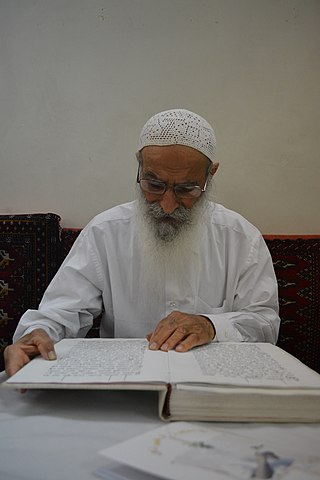In Mandaeism, kushta or kušṭa can have several meanings. Its original literal meaning is "truth" in the Mandaic language, and is thus typically used to refer to the Mandaean religious concept of truth. The same word is also used to refer to a sacred handclasp that is used during Mandaean rituals such as the masbuta, masiqta, and priestly initiation ceremonies.
In Mandaeism, Rūha is the queen of the World of Darkness or underworld. She rules the underworld together with her son Ur, the king of the World of Darkness, and her entourage of the seven planets and twelve constellations, who are also her offspring with Ur.
In Mandaeism, Ptahil also known as Ptahil-Uthra, is the Fourth Life, the third of three emanations from the First Life, Hayyi Rabbi, after Yushamin and Abatur. Ptahil-Uthra alone does not constitute the demiurge but only fills that role since he is viewed as the creator of the material world in the Ginza Rabba, often holding an inherently malicious character.
In Mandaeism, the World of Light or Lightworld is the primeval, transcendental world from which Tibil and the World of Darkness emerged.
An uthra or ʿutra is a "divine messenger of the light" in Mandaeism. Charles G. Häberl and James F. McGrath translate it as "excellency". Jorunn Jacobsen Buckley defines them as "Lightworld beings, called 'utras ." Aldihisi (2008) compares them to the yazata of Zoroastrianism. According to E. S. Drower, "an 'uthra is an ethereal being, a spirit of light and Life."
The Right Ginza is one of the two parts of the Ginza Rabba, the longest and the most important holy scripture of Mandaeism. The other part of the Ginza Rabba is the Left Ginza.

The Left Ginza is one of the two parts of the Ginza Rabba, the longest and the most important holy scripture of Mandaeism. The other part of the Ginza Rabba is the Right Ginza.
Mandaean cosmology is the Gnostic conception of the universe in the religion of Mandaeism.
In Mandaean cosmology, Tibil or occasionally Arqa ḏ-Tibil is the Earth (World) or earthly middle realm. It is separated from the World of Light above and the World of Darkness below by ayar (aether).

The masiqta is a mass or ritual practiced in the Mandaean religion in order to help guide the soul (nišimta) towards the World of Light in Mandaean cosmology. They are typically performed as funerary rites for Mandaeans who have just died. Although usually translated as "death mass", a few types of masiqta are also performed for living people, such as when priests are ordained. Masiqtas are also used to consecrate houses of worship.
In Mandaean cosmology, a maṭarta is a "station" or "toll house" that is located between the World of Light from Tibil (Earth). It has variously been translated as "watch-station", "toll-station", "way-station", or "purgatory". Maṭartas are guarded by various uthras and demons. Ruha, the queen of the underworld, is the ruler or guardian of one of the maṭartas.
A ganzibra is a high priest in Mandaeism. Tarmidas, or junior priests, rank below the ganzibras.
In Mandaeism, the World of Darkness is the underworld located below Tibil (Earth). It is ruled by its king Ur the Leviathan and its queen Ruha, mother of the seven planets and twelve constellations.

In Mandaeism, a shkinta or shkina (škina) is a celestial dwelling inhabited by uthras in the World of Light that is analogous to the shekhinah in Jewish mysticism. In Tibil, it refers to a reed or mud hut that is used during Mandaean priest initiation ceremonies, since Mandaean priests represent uthras on earth.
In Mandaeism, Shilmai or Shalmai (Šalmai) is an uthra who serves as one of the two guardian spirits of Piriawis, the heavenly yardna (river) in the World of Light. In the Ginza Rabba and Qulasta, he is usually mentioned together with Nidbai.

Dehwa Rabba or Nauruz Rabba is the Mandaean New Year. It is the first day of Daula, the first month of the Mandaean calendar.
In Mandaeism, Simat Hayyi or Simat Hiia, the personification of life, is an uthra from the World of Light who is married to Yawar Ziwa.
The Mandaic word mana (ࡌࡀࡍࡀ) is a term that is roughly equivalent to the philosophical concept of nous. It has been variously translated as "mind", "soul", "treasure", "Garment", "Intellect", "Intelligence", "Heart", "Spirit", "Being"; or alternatively as "nous", "consciousness", or "vessel".
In Mandaeism, a dmuta or dmut is a spiritual counterpart or "mirror image" in the World of Light. People, spirits, and places are often considered to have both earthly and heavenly counterparts (dmuta) that can dynamically interact with each other. A few examples include:
The following outline is provided as an overview of and topical guide to Mandaeism.






